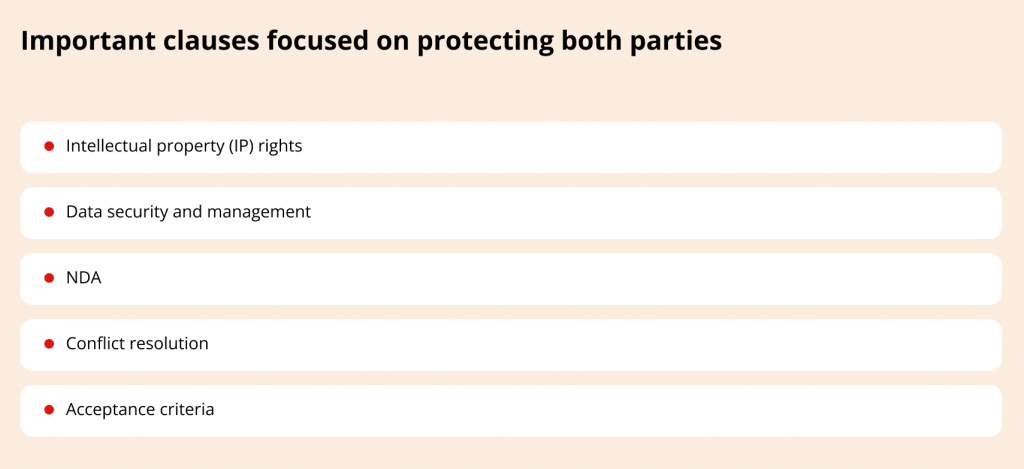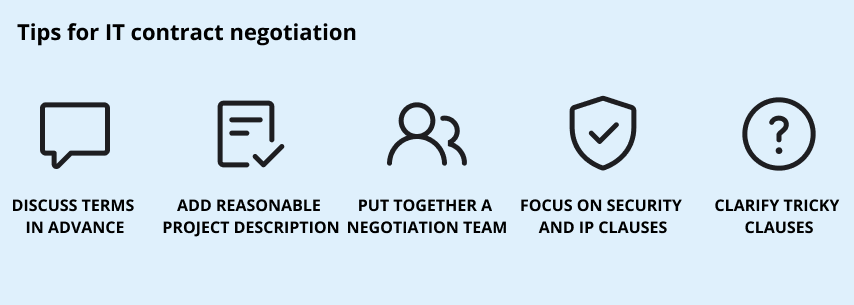Work out a win-win strategy for negotiating IT contracts with your tech partners and vendors.
In my experience, IT contract negotiation can be considered successful only if both parties – a client and a vendor – are confident with the results and believe they’ve reached a win-win agreement. On the contrary, when at least one of the parties is not quite comfortable with some terms but signs a contract for the sake of closing a deal, it’s a wake-up call telling there’s room for improvement.
Unfortunately, many standard software and IT contracts contain controversial clauses which may become the source of a problem for software development collaboration. During my 25+ years in IT, I had a chance to go through all sorts of contracts and customize dozens of them, both as an IT vendor and as a client.
Here’re some tips for negotiating an IT contract and getting a win-win deal at the outcome.
5 tips for negotiating an IT contract
Tip 1. Get all bases covered before you get down to IT contract negotiation
This is probably one of the negotiation strategies to get to contract signing with no conflict or losses. I believe it’s essential to discuss and most importantly reach a full mutual understanding regarding all key terms of the agreement before we actually get down to paperwork.
To make sure an IT contract fulfills project objectives and reflects the requirements and expectations on both ends, we go through all the terms in advance.
Usually, the terms are discussed as early as at the presale. This is how we know how to start a contract and what to start with. At this stage, we conduct a series of calls and introductory meetings. Thus, we can agree upon the project timeline, scope and plan of work, IT team augmentation terms, communication methods, payment terms, guarantees, as well as data security and intellectual property terms. Thus, we make sure to avoid surprises during the course of your negotiation and minimize paperwork time for the good of the project.
Tip 2. Put together a complete negotiation team
When dealing with an IT contract negotiation, don’t throw all the work on a legal team. In my practice, this approach can lead to very poor consequences, since lawyers often have little to no understanding of your business context and project goals.
Instead, put together a neat team that includes both product owners and legal specialists. In this case, product owners ensure the contract reflects the reality of the project and aligns with the goals of both parties, while a legal team controls the legitimacy of the deal.
Now, it doesn’t necessarily mean that you need a 5-person team for negotiating contracts for IT companies and clients. In fact, it can be one person with a good understanding of the project and related business environment and adequate legal expertise to handle an IT contract. The main condition for this person is to have a good judgment on both business and legal context of the contract.
Having trouble finding a reliable tech vendor or setting up a tech partnership that ticks all the boxes? Contact our team and tell us about your software development needs and expectations from your vendor.
Contact Digiteum
Tip 3. Make a reasonably detailed project description
In fact, what to consider being a reasonably detailed project description depends on the case. In my experience, the clients who have burned on unfortunate deals before prefer having a very detailed contact where every minute term is taken into consideration. Often, such contracts include extensive development plans, strict timeframes and milestones, team description, and penalty terms for the missed deadlines.
However, this is the exception rather than the rule. And it’s not likely to work out in the real world. In fact, the most efficient approach to project development today is the agile methodology, and it was proven by years of software development expertise. Agile implies dynamic iterative project flow, two or four week-long sprints, and changes in a project scope from sprint to sprint. In this environment, any project scope recorded in a contract may become obsolete after the very first sprint.
In most cases, a reasonably detailed IT contract includes generic terms of the project – scope, project budget, payment terms, development methodology, approach to discussing and approving change requests and software product requirements management, high-level development plan, acceptance criteria, team structure, milestones, and a deadline.
Instead of the detailed specifications, the focus is shifted to project scope, objectives, and stakeholders’ goals. Using this negotiation and agreement strategy, we still specify what is considered to be a working product at delivery and how we plan to get there. Though we omit unnecessary details that may change over the course of development.
Tip 4. Protect yourself
There’s a range of clauses that deserve special attention from both sides in IT contract negotiation. Intellectual property (IP) rights, data security, NDA, conflict resolution, acceptance criteria – all these clauses are focused on protecting both parties and are equally important for the confidence of a client and a vendor.

NDA is signed in advance and only partially reflected in the IT contract. This is not the case for IP and data security terms. A fundamental understanding of these terms is the responsibility of both parties.
Usually, a client reasonably insists on reserving all IP rights. As a vendor, we support this position and eagerly give all the rights to unique code and documentation created within the scope of the project to a client.
However, if the code, documentation, or other protected information used on the project hasn’t been created exclusively for a particular client but constitutes a part of the vendor’s know-how, a client can’t reserve the right for this information. In this case, a client gets the license to use this information.
The data security clause gains utmost importance in the data-driven world and therefore is utterly important in IT contract negotiation. What clients should bear in mind is that NDA doesn’t have anything to do with data procedures along with project development. Therefore, every client should carefully go through the data security clause to make sure the terms of encryption, password protection, server security, data access, and compliance with laws and privacy policy are in line in the contract.
Here are two more points in this section. Conflict resolution is an important clause of the contract, even though it’s better to avoid referring to this part of the agreement over the course of the project’s lifecycle. As a rule, all conflicts are resolved according to the legislation of the client’s country of residence. For this reason, it’s crucial for a vendor to have at least a high-level understanding of the regulations and laws related to the contract in the client’s country of residence.
Also for the vendor’s benefit, it’s important to have reasonably detailed acceptance criteria defined in the contract. These criteria help figure out if the final product matches the expectations and requirements of the client after the product’s launch and if the vendor’s job is considered to be well-done according to the contract.
Tip 5. Consider tricky clauses
IP and data security are not the only clauses that require special attention in IT contract negotiation. In fact, during many years in this domain, I came to the conclusion that support and maintenance terms somehow cause the most confusion.
Usually, clients are secured with an up to 3-month service guarantee that requires a vendor to look after the product upon its launch, fix bugs, and solve other problems with the system at no additional cost. This guarantee period may last for as long as 6 months in a production mode, for example, in healthcare when prompt update and consistency of a system is crucial.
However, upon the completion of the guarantee period starts the support and maintenance period, usually on a fee-paid basis. In order to avoid misunderstanding months after the product launch, it’s important for a client to consider support and maintenance terms in advance. Otherwise, clients risk getting the terms they are unhappy with: expensive 24/7 support or lack of thereof when it’s needed.
Mistakes to avoid when negotiating IT contracts
Miscommunication
When negotiating deals or contract terms, it’s essential that both parties focus on clear and open communication and don’t rush the process. Failing to communicate expectations or clarify vague or confusing terms may lead to serious problems afterward. On the contrary, open and transparent negotiation will help you work out a mutual understanding with a vendor or a client. After all, one of the most important goals at this step is to understand each others’ expectations and set the foundation for future work.
Lack of visibility
When two negotiation teams actively work on the terms on each end, there’s a chance that some edits may go unnoticed by one side and get to the final version. This is why it’s important to not only double-check but also keep track of all the edits on both ends to ensure everyone is on the same page. I recommend working out an effective workflow that allows both sides to communicate any change they make and drive visibility into the process.
Fail to address modern remote-first practices
Today’s cooperation framework is different from what we had 10 or even 5 years ago. Remote/hybrid work became a norm after the pandemic, and so many conditions related to location, team communication, and office hours changed as well. Modern IT contracts should reflect these changes and adjust to emerging frameworks and workspace arrangements.
Consider Digiteum as your trusted technology partner
A trusted technology vendor will help you navigate the specifics of the IT contract, customize the terms and develop an effective agreement that takes into consideration the goals and interests of both sides.
As a software development company with over a decade-long experience, we have worked with dozens of clients from the US, UK, EU, Canada, and Australia and developed effective collaboration frameworks that best fit our clients’ requirements and needs.
If you are looking for a seasoned tech vendor who values mutually beneficial collaboration, contact our specialists.
Contact Digiteum
Just to wrap it up
These 5 tips on how to negotiate IT contracts will be helpful for both vendors and their clients. Profound knowledge of the structure and content of an IT contract is important for both sides to better understand their responsibilities and rights as contractors. This understanding in turn is the first step to getting win-win results on both ends.
FAQ
- Communicate and discuss all the key terms in advance
- Get a negotiation team that includes people from project and legal teams
- Include key project description and terms (scope, budget, payment terms, team composition, etc.)
- Focus on security, IP rights and data safety terms
- Clarify all tricky or confusing terms








